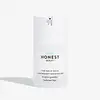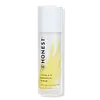What's inside
What's inside
 Key Ingredients
Key Ingredients

 Benefits
Benefits

 Concerns
Concerns

 Ingredients Side-by-side
Ingredients Side-by-side

Water
Skin ConditioningCaprylic/Capric Triglyceride
MaskingNeopentyl Glycol Diethylhexanoate
EmollientPolyglyceryl-2 Stearate
EmulsifyingCetearyl Alcohol
EmollientPropanediol
SolventCetyl Alcohol
EmollientGlycerin
HumectantPhytosterols
Skin ConditioningPhospholipids
Skin ConditioningHydrolyzed Sodium Hyaluronate
Skin ConditioningTrisodium Ethylenediamine Disuccinate
Sclerotium Gum
Emulsion StabilisingHydroxyacetophenone
AntioxidantAllantoin
Skin ConditioningLinoleic Acid
CleansingJojoba Esters
EmollientTocopherol
AntioxidantCetearyl Phosphate
Skin ConditioningSodium Hydroxide
Buffering1,2-Hexanediol
Skin ConditioningCaprylyl Glycol
EmollientCitric Acid
BufferingWater, Caprylic/Capric Triglyceride, Neopentyl Glycol Diethylhexanoate, Polyglyceryl-2 Stearate, Cetearyl Alcohol, Propanediol, Cetyl Alcohol, Glycerin, Phytosterols, Phospholipids, Hydrolyzed Sodium Hyaluronate, Trisodium Ethylenediamine Disuccinate, Sclerotium Gum, Hydroxyacetophenone, Allantoin, Linoleic Acid, Jojoba Esters, Tocopherol, Cetearyl Phosphate, Sodium Hydroxide, 1,2-Hexanediol, Caprylyl Glycol, Citric Acid
Water
Skin ConditioningGlycerin
HumectantPropanediol
SolventPyrus Malus Fruit Extract
Skin ConditioningCynara Scolymus Leaf Extract
Skin ConditioningAloe Barbadensis Leaf Juice Powder
Skin ConditioningDiglucosyl Gallic Acid
Citric Acid
BufferingLysolecithin
EmulsifyingSclerotium Gum
Emulsion StabilisingXanthan Gum
EmulsifyingPullulan
Silica
AbrasiveSodium Acetylated Hyaluronate
HumectantSodium PCA
HumectantErythritol
HumectantCarrageenan
Hydrolyzed Sodium Hyaluronate
Skin ConditioningIsopentyldiol
HumectantTrifolium Pratense Flower Extract
AstringentCananga Odorata Flower Water
Skin ConditioningTrisodium Ethylenediamine Disuccinate
1,2-Hexanediol
Skin ConditioningCaprylhydroxamic Acid
Sodium Ascorbyl Phosphate
AntioxidantTin Oxide
AbrasiveBenzoic Acid
MaskingSorbic Acid
PreservativeSodium Hydroxide
BufferingPotassium Sorbate
PreservativeSodium Benzoate
MaskingCI 77891
Cosmetic ColorantMica
Cosmetic ColorantWater, Glycerin, Propanediol, Pyrus Malus Fruit Extract, Cynara Scolymus Leaf Extract, Aloe Barbadensis Leaf Juice Powder, Diglucosyl Gallic Acid, Citric Acid, Lysolecithin, Sclerotium Gum, Xanthan Gum, Pullulan, Silica, Sodium Acetylated Hyaluronate, Sodium PCA, Erythritol, Carrageenan, Hydrolyzed Sodium Hyaluronate, Isopentyldiol, Trifolium Pratense Flower Extract, Cananga Odorata Flower Water, Trisodium Ethylenediamine Disuccinate, 1,2-Hexanediol, Caprylhydroxamic Acid, Sodium Ascorbyl Phosphate, Tin Oxide, Benzoic Acid, Sorbic Acid, Sodium Hydroxide, Potassium Sorbate, Sodium Benzoate, CI 77891, Mica
 Reviews
Reviews

Ingredients Explained
These ingredients are found in both products.
Ingredients higher up in an ingredient list are typically present in a larger amount.
1,2-Hexanediol is a synthetic liquid and another multi-functional powerhouse.
It is a:
- Humectant, drawing moisture into the skin
- Emollient, helping to soften skin
- Solvent, dispersing and stabilizing formulas
- Preservative booster, enhancing the antimicrobial activity of other preservatives
Citric Acid is an alpha hydroxy acid (AHA) naturally found in citrus fruits like oranges, lemons, and limes.
Like other AHAs, citric acid can exfoliate skin by breaking down the bonds that hold dead skin cells together. This helps reveal smoother and brighter skin underneath.
However, this exfoliating effect only happens at high concentrations (20%) which can be hard to find in cosmetic products.
Due to this, citric acid is usually included in small amounts as a pH adjuster. This helps keep products slightly more acidic and compatible with skin's natural pH.
In skincare formulas, citric acid can:
While it can provide some skin benefits, research shows lactic acid and glycolic acid are generally more effective and less irritating exfoliants.
Most citric acid used in skincare today is made by fermenting sugars (usually from molasses). This synthetic version is identical to the natural citrus form but easier to stabilize and use in formulations.
Read more about some other popular AHA's here:
Learn more about Citric AcidGlycerin is already naturally found in your skin. It helps moisturize and protect your skin.
A study from 2016 found glycerin to be more effective as a humectant than AHAs and hyaluronic acid.
As a humectant, it helps the skin stay hydrated by pulling moisture to your skin. The low molecular weight of glycerin allows it to pull moisture into the deeper layers of your skin.
Hydrated skin improves your skin barrier; Your skin barrier helps protect against irritants and bacteria.
Glycerin has also been found to have antimicrobial and antiviral properties. Due to these properties, glycerin is often used in wound and burn treatments.
In cosmetics, glycerin is usually derived from plants such as soybean or palm. However, it can also be sourced from animals, such as tallow or animal fat.
This ingredient is organic, colorless, odorless, and non-toxic.
Glycerin is the name for this ingredient in American English. British English uses Glycerol/Glycerine.
Learn more about GlycerinThis ingredient is created by putting sodium hyaluronate through hydrolysis.
You might know this as 'mini' or 'ultra low-molecular weight' hyaluronic acid. The small molecule size means it is able to travel deeper in the skin.
According to studies, low molecular-weight hyaluronic acid can:
One study from 2011 found ultra-low weight HA to show pro-inflammatory properties. Another study from 2022 found it to downregulate UV-B induced inflammation.
Hydrolysis is a process of changing a molecule using water or enzymes.
This ingredient is water-soluble.
Learn more about Hydrolyzed Sodium HyaluronatePropanediol is an all-star ingredient. It softens, hydrates, and smooths the skin.
It’s often used to:
Propanediol is not likely to cause sensitivity and considered safe to use. It is derived from corn or petroleum with a clear color and no scent.
Learn more about PropanediolSclerotium Gum is a polysaccharide gum made by the fungus, Sclerotium rolfssii. It is similar to xanthan gum.
In cosmetics, Sclerotium Gum is used to thicken the texture and to help stabilize other ingredients.
As an emulsifier, Sclerotium Gum helps prevent ingredients from separating, such as water and oil.
Learn more about Sclerotium GumSodium Hydroxide is also known as lye or caustic soda. It is used to adjust the pH of products; many ingredients require a specific pH to be effective.
In small amounts, sodium hydroxide is considered safe to use. However, large amounts may cause chemical burns due to its high alkaline.
Your skin has a natural pH and acid mantle. This acid mantle helps prevent harmful bacteria from breaking through. The acid mantle also helps keep your skin hydrated.
"Alkaline" refers to a high pH level. A low pH level would be considered acidic.
Learn more about Sodium HydroxideTrisodium Ethylenediamine Disuccinate is used to help stabilize a product.
It is a chelating agent, meaning it helps prevent metal ions from binding to other ingredients. This prevents unwanted reactions in products. Metal ions can come into a product via the water ingredient. They are found in trace amounts and are not known to be harmful.
Water. It's the most common cosmetic ingredient of all. You'll usually see it at the top of ingredient lists, meaning that it makes up the largest part of the product.
So why is it so popular? Water most often acts as a solvent - this means that it helps dissolve other ingredients into the formulation.
You'll also recognize water as that liquid we all need to stay alive. If you see this, drink a glass of water. Stay hydrated!
Learn more about Water